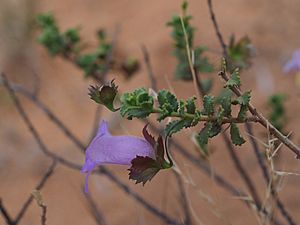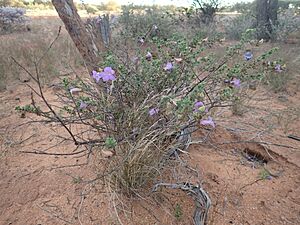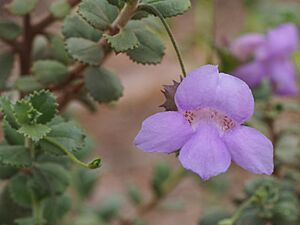Eremophila flabellata facts for kids
Quick facts for kids Eremophila flabellata |
|
|---|---|
 |
|
| Eremophila flabellata leaves and flowers | |
| Scientific classification | |
| Genus: |
Eremophila (plant)
|
| Species: |
flabellata
|
Eremophila flabellata is a pretty flowering plant that belongs to the figwort family. It grows only in Western Australia, meaning it is endemic to that area. This plant is a small shrub with leaves that have jagged edges. Its flowers can be pink, purple, or mauve.
Contents
What it Looks Like
Eremophila flabellata is a shrub that usually grows to less than 0.5 m (1.6 ft) tall. Its branches and leaves are often sticky and shiny because of a natural sap called resin. They are also covered with tiny hairs. The leaves grow one after another along the stem. They are usually 8-12 mm (0.3-0.5 in) long and 5.5-8.5 mm (0.2-0.3 in) wide. They are shaped like an egg or are almost round, and they have jagged, saw-like edges.
The flowers grow one by one on a hairy stalk that is 20-40 mm (0.8-1.6 in) long. Each flower has 5 overlapping, hairy, green to purple sepals. Sepals are like small leaves that protect the flower bud. These sepals are 8-11.5 mm (0.3-0.5 in) long and are egg-shaped or fan-shaped with very jagged edges. The petals are 15-25 mm (0.6-1.0 in) long and are joined together at their bottom to form a tube. The outside of the petals is pink, mauve, or purple, while the inside of the tube is white. The outside of the petal tube is hairy, but the tips of the petals are smooth. The inside of the tube is full of soft, woolly hairs. Inside the petal tube are 4 stamens, which are the parts of the flower that make pollen.
This plant flowers from May to September. After flowering, it produces fruits that are dry, woody, and hairy. They are shaped like a narrow oval or are almost round, and they have a papery covering. These fruits are 7-8.5 mm (0.28-0.33 in) long.

How it Got its Name
Eremophila flabellata was first officially described by a scientist named Robert Chinnock in 2007. He published his description in a book about the plant family Myoporaceae. The first plant specimen used to describe the species, called the type specimen, was collected by Chinnock in 1986. He found it about 15 km (9.3 mi) south-west of Wiluna. The second part of the plant's name, flabellata, comes from a Latin word meaning 'fan-shaped'. This refers to the fan-like shape of the sepals on this plant.
Where it Grows
This type of eremophila plant often grows in mulga woodland areas. It prefers red-brown clay soil. You can find it in the Meekatharra and Wiluna areas of Western Australia. These areas are part of a larger natural region called the Murchison biogeographic region.
Conservation Status
The Western Australian Government Department of Parks and Wildlife has classified Eremophila flabellata as "not threatened." This means that the plant is not currently in danger of disappearing.
Growing it in Gardens
Eremophila flabellata is not often grown in home gardens. However, it has interesting jagged leaves and colourful flowers that make it attractive. It can be tricky to grow new plants from its seeds or from cuttings (small pieces of the plant). It is also one of the few plants in its group that cannot be grafted onto Myoporum rootstock. Grafting is a way to join parts of two plants so they grow as one. This plant prefers soil that drains well and a sunny spot. It can also handle light frosts.


